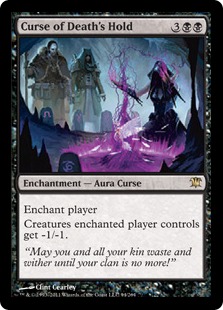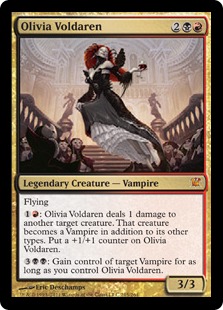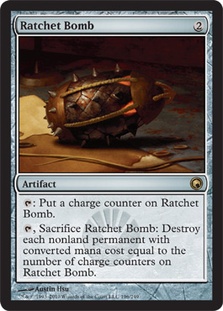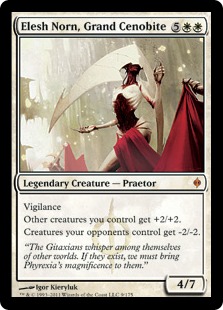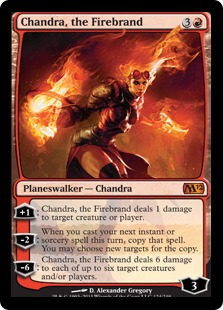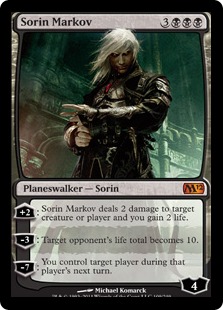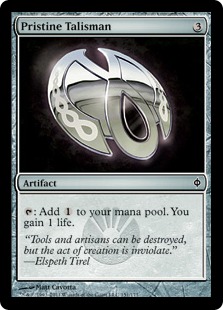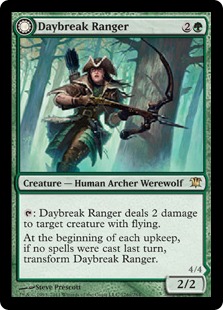My initial idea for this week was to give my first thoughts on Modern, since the PTQ season is quickly approaching, and the format remains relatively unexplored since the bannings. Then I opened up SCG on Monday and saw a pair of Modern articles by Chapin and Gerry staring at me, with the “Part 1” in Gerry’s title promising more to come. While I certainly have my own ideas about how the format is going to shape up, right now they are only that—ideas. I haven’t actually played a game of Modern since Worlds, so I figured rather than add to the deluge of Modern information this week with uninformed speculation, I’d give myself some time to try out some of my ideas. In the meanwhile, I want to talk about something I have played a lot of recently: Standard.
If you’ve been playing any amount of Standard on Magic Online recently, you’ve probably experienced the same thing I have. An eerie, uncomfortable feeling in almost every match you play. Just when you think you’ve gotten rid of it, it seems to come right back. You just can’t seem to shake it, no matter how hard you try. It’s unbelievable, but unmistakable—Standard is haunted.
I understand if you may be skeptical. Lots of people don’t believe in such things. But take a moment and check out the “What’s Happening” page on the Magic Online website. Scroll through the results from Standard Daily and Premier events. Go ahead, I’ll wait.
What’s that? The same sense of foreboding, as you saw list after list? Yeah, I felt it too. Ruh roh, Raggy! The dead just don’t get a chance to rest these days because Moorland Haunt is everywhere. And it’s not just Illusions, either, though Phantasmal Bear and friends are among the top offenders. No, Moorland Haunt is making its supernatural presence felt in a wide variety of decks, and a disconcerting number of those decks are making their presence felt at the top tables of Standard tournaments online. Let’s take a look at a few examples of 4-0 decks from the Standard Daily Events over the past week:
Creatures (22)
- 4 Phantasmal Bear
- 4 Lord of the Unreal
- 3 Phantasmal Image
- 4 Snapcaster Mage
- 3 Geist of Saint Traft
- 4 Delver of Secrets
Lands (20)
Spells (18)

This is a pretty Standard Illusions maindeck with all of the usual suspects. Of particular note are the Sword of War and Peace and Mortarpod in the sideboard. One of the most attractive aspects of Moorland Haunt is the ability for the Spirit tokens to carry equipment. Much like Squadron Hawk helped overcome the traditional vulnerability of equipment—that is, a weakness to removal due to the requirement of a body to carry it—Moorland Haunt provides a seemingly inexhaustible stream of bodies to pick up Swords and the like. It says a lot that this deck includes equipment in the sideboard when it has seven Illusions in the maindeck that can’t even look at a weapon without dying.
Creatures (13)
Lands (21)
Spells (26)
- 1 Dissipate
- 4 Mana Leak
- 4 Ponder
- 3 Gitaxian Probe
- 4 Vapor Snag
- 1 Dismember
- 3 Gut Shot
- 4 Midnight Haunting
- 2 Runechanter's Pike
Sideboard

Speaking of carrying equipment—now this is a deck that looks to go all the way with a suited-up token. Eschewing the usual Phantasmal Bear/Lord/Image package, this deck focuses on hard-to-remove threats backed up by the same countermagic and tempo package that makes up the rest of the Illusions shell. In addition, this deck plays Runechanter’s Pike, a card that has started to get a lot more attention lately. While some Illusions players are using cards like Sword or Mortarpod or Sylvok Lifestaff to get extra value out of their Spirit tokens, this kind of deck can deal a huge amount of damage out of nowhere with as little as a single token in play. The resilience of everyone’s favorite spooky mansion—alongside Midnight Haunting and hexproof creatures like Geist and Invisible Stalker—makes this deck much better suited to fight against removal-based strategies than its more aggressive cousin. A single hit from a Pike-powered Spirit can end the game in a hurry.
There are a lot of decks that fall between these two on the spectrum of base-blue Moorland Haunt decks. Their core strategy is to lean on the tempo of cards like Delver, Vapor Snag, and Mana Leak to pressure your opponent early while relying on Moorland Haunt and Snapcaster Mage to provide the fuel to play a long game when need be. As you can see from the major differences between these two builds, there’s a lot of room to play around with when it comes to individual card choices because the core is so powerful—and a huge part of that power comes from the resilience provided by Moorland Haunt.
And now for something not-quite-completely different:
Creatures (26)
- 4 Mirran Crusader
- 3 Hero of Bladehold
- 2 Gideon's Lawkeeper
- 4 Grand Abolisher
- 2 Fiend Hunter
- 4 Champion of the Parish
- 3 Geist of Saint Traft
- 4 Doomed Traveler
Lands (24)
Spells (10)

At the other side of Moorland Haunt’s chromatic spectrum, we find W/u Humans. This is a deck that I know Brad Nelson has been championing recently, and for good reason. W/u Humans doesn’t have quite the same ability to put the opponent on the back foot that the Delver decks do (although some Champion of the Parish draws can be absolutely brutal), but it has much more powerful individual threats. Hero of Bladehold, in particular, can end the game incredibly quickly if left unchecked. This is a deck that packs a lot of punch.
On the face of it, W/u Humans is yet another midrange creature deck—the sort of deck that tends to prey upon the slightly faster creature decks but loses to control. But Moorland Haunt is the control killer, at least in the traditional sense. Even if a control deck may be able to deal with the initial wave of creatures—many of which, like Grand Abolisher, Doomed Traveler, and Mirran Crusader, can give control decks trouble in their own right—there’s still Haunt to deal with.
And much like Haunt breathes new life into equipment, it makes Honor of the Pure not only a safer investment but an absolute monster. Any kind of creature-enhancing effect is reliant on actually having a creature around to boost. Crusade effects, in particular, rely on having a certain critical mass of creatures to pump before they’re worthwhile. Moorland Haunt provides exactly that, ensuring that the very Honor of the Pure that was boosting your Mirran Crusader and Doomed Traveler in life does the same for them after they’ve gone to a better place—that place being in the air as Spirits, it seems.
Creatures (20)
Lands (20)
Spells (20)

This last one might not be a list many of you were expecting to see included with the Moorland Haunt decks, but it deserves to be included. A lot of players think of Tempered Steel as a deck that lives and dies purely by its namesake card, and while it is true that the deck plays completely differently when it does and does not have the enchantment in play, it isn’t true that it’s dead in the water without it. The version of Tempered Steel we played at Worlds—which this list is nearly identical to—was built to be both explosive and able to win the hard games where you don’t just kill them on turn three.
Moorland Haunt is a part of that plan. In a deck like this, every damage adds up, and with cards like Signal Pest and Hero of Bladehold (excluded from this list but a key component of our sideboard at Worlds), every body adds up too. While the Spirits from Moorland Haunt aren’t as exciting as a Myr token from Origin Spellbomb or Shrine of Loyal Legions, since Tempered Steel does nothing for them, they can still get boosts from battle cry, and that damage adds up. Tempered Steel gets a bad rap as an all-or-nothing deck, but it really has a lot of opportunities to squeeze in extra damage that all matter.
The older players among you might remember how powerful Kjeldoran Outpost was during its time in Standard. Control decks went so far as to play land destruction effects specifically to kill opposing Outposts—even Political Trickery was a maindeck quality card! Outpost was so powerful that it spawned archetypes that won exclusively with the land—“Counter-Post” decks were an early favorite of none other than Jon Finkel, and such a deck was in fact what yours truly used to win a grinder for US Nationals way back in 1997.
Moorland Haunt requires a bit more commitment than Kjeldoran Outpost did—after all, you need creatures to fuel it—but after that, it’s almost a strict upgrade. Outpost made you sacrifice a land when it came into play, preventing it from being used as an early game mana source and keeping it out of most land-light decks (especially given the lack of the Paris mulligan rule back then). Both lands make 1/1 creatures, but Moorland Haunt’s tokens have flying—a fact that is anything but trivial when you’re trying to defend against them. Trying to stave off the Moorland Haunt assault with blockers can lead a man to desperate measures—how do you think I ended up playing with Viral Drake?
So how do you stop Moorland Haunt? Unlike in the days of Kjeldoran Outpost, we don’t have much in the way of quality land destruction. Along with Zendikar block rotated the real quality land destruction we had in the form of Tectonic Edge and Goblin Ruinblaster. We still have Acidic Slime, but most decks that can cast Slime these days are Primeval Titan decks, and Moorland Haunt isn’t really what’s causing them trouble.
Ghost Quarter is a theoretical solution, but it comes at a high cost. Playing Ghost Quarter in the first place can put a lot of pressure on your mana base, so it can only generally fit in decks that can support 26+ land—and those decks tend to value their land drops, so it can be difficult to find a time to use it that doesn’t set you back.
My preferred method of combatting Moorland Haunt is with powerful permanents of my own. Let’s take a look at who to call when there’s something strange in your neighborhood: The Ghostbusters.
I’ve talked about this one quite a bit recently, and I think it’s worthy of another mention. Curse is an incredibly powerful card against the many Illusions and son-of-Illusions decks we see running around these days. Not only does it kill virtually every creature in their deck, but it keeps them dead forever. Two Curses and not even Geist of Saint Traft will show up to spook you. This is the containment unit, if you will. I include at least one of these somewhere in the 75 of every control deck I build that can support it because it’s often just lights out for the ghosts. That said, Curse is expensive at five mana and isn’t a reliable answer to Haunt against Humans thanks to Honor of the Pure, so it can’t be all you rely on.
Apparently, Vampires fight Werewolves, so why not ghosts too? Olivia had a huge spike in popularity after showing up in Patrick Chapin Grixis deck at Worlds but has mostly dropped off the radar since. She’s very powerful against both Illusions and Humans but at the cost of her vulnerability to removal. Vapor Snag and Oblivion Ring in particular can make it difficult to rely upon this vampiric matriarch to solve your problems, but she’s a powerhouse if she can stick around and completely dominates the board once you get to seven mana. Her saddest vulnerability, though, is her status as a Legend. Not because of the threat of other people playing her, mind you, but Phantasmal Image doubles as Hero’s Demise. Oh silly mechanics, I hate you so.
This one isn’t as dominant as the previous two but is surprisingly effective, especially with a little help from some friends. Andrew Cuneo’s undefeated list from Worlds leaned on Ratchet Bomb very heavily, including three copies along with several Buried Ruins—with no other artifacts in his deck! It is important to note that Moorland Haunt is not Kjeldoran Outpost—the supply of creatures it can generate is not actually infinite, even though it often seems that way. Ratchet Bomb can often clear out enough tokens to buy you breathing room and—alongside Buried Ruin—can keep the token count low enough that you can stabilize with some other powerful permanent. Historically, I’ve hated Ratchet Bomb and felt like it ended up in way too many decks and sideboards where it didn’t belong, but I think the popularity of Moorland Haunt, Midnight Haunting, and Delver give a Bomb on zero enough value that it’s worth a look.
When someone asks you if you’re a God—you say YES! Elesh Norn is pretty much what Gozer the Destructor would have looked like if Ray hadn’t had the presence of mind to think of the Stay-Puft Marshmallow Man—but in this case, she’s on the Ghostbusters’ side. The legendary Praetor has the impact of double Curse of Death’s Hold in a single card—but then again, you get what you pay for. For seven mana, you’d better be winning the game, especially against decks packing countermagic in spades. I think Elesh Norn is absolutely the fatty of choice for control decks that can support her. Like Olivia, she suffers from the problems of “is a creature” and “is a legend,” but even if Elesh Norn gets bounced or died, all of your opponent’s creatures are still dead. If I were to play any kind of traditional control deck with white, I’d certainly have several Elesh Norns somewhere in my 75.
Chandra has gotten the short end of the stick as far as planeswalkers go—but that’s probably because she lights the stick on fire whenever someone hands it to her. That said, I think it may be Chandra’s time. No, not because it’s just that awesome when you copy a Sorin’s Vengeance with Chandra’s -2 ability—though it is. But Chandra is an incredibly effective answer to an opposing Moorland Haunt. She kills tokens while building toward a powerful ultimate. I was toying with Chandra in my B/r Infect deck because she’s so good with Tezzeret’s Gambit and found that she had a lot of applications I hadn’t initially considered along with keeping ghosts where they belong—dead. I suspect we’ll see more of Chandra as Standard matures.
Now this suggestion, unlike the others on this list, is backed up by absolutely zero playtesting. But think about it. If Chandra’s +1 ability is good for keeping Spirits under control, how good is Sorin’s +2? I’ve been playing around with Sorin’s Thirst as a sideboard card for creature decks against which lifegain is particularly relevant, and even the single-shot two life is a big deal a lot of the time. With big poppa Sorin, you can quickly get yourself out of range of burn while keeping the ghosts under control. Yes, he costs six mana. Yes, you can get a Grave Titan for that much. Maybe it’s not worth it. But it’s definitely worth trying.
This one has gotten played a reasonable amount lately and is a card that I kind of like. I don’t tend to like the decks it actually ends up in, but I like what it does in those decks. As I mentioned above, lifegain can have a major impact on the pace of games against aggressive decks, and Talisman both gains you life and accelerates you to larger, more powerful threats like Elesh Norn. Talisman does a great job of forcing your opponent to commit more resources to the board, making the Haunt grind-out plan much less effective at whittling you down. I feel like I have to say that Talisman seems much less effective against the new breed of Illusion decks sporting equipment like Runechanter’s Pike, though—those ghosts are hitting much too hard to ignore with a Fountain of Youth effect.
And last, but certainly not least…
Is it time? IS IT REALLY TIME? We shall see….
That’s it for this week. I’ll be back next week, perhaps with that look at Modern. In the meantime, I’ve started to get things together so I can actually stream some of my Magic Online matches. Check out my channel below and tune in—I’ll be announcing any time I’m streaming on Twitter, so be sure to follow me there too.
Until next time,
bmk
@bmkibler on Twitter

